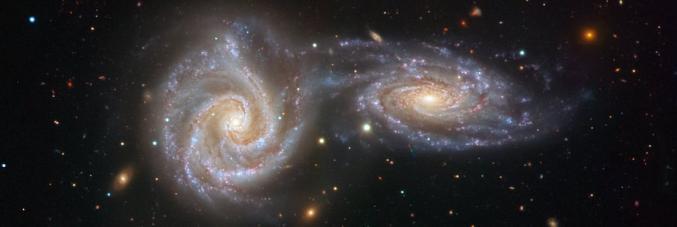
Merging Galaxies in the Early Universe
08.10.2021
An international team of astronomers, coordinated by the University of Padua PhD student Michael Romano and colleagues from the National Institute of Astrophysics (INAF) found that about 40% of galaxies in the early Universe are found in merging systems. This discovery confirms that in the early stages of their evolution, galaxies significantly increased their mass by merging with each other.
Collisions between galaxies (galactic mergers) occur when two or more galaxies get close enough and begin spiralling with each other due to gravity, until they merge into a single larger galaxy. If the two galaxies have more or less the same number of stars (therefore the same stellar mass), the resulting galaxy will have about twice the mass of the individual ones, which is understood as the fastest mechanism by which galaxies grow. However, only 1% of the galaxies in the local Universe are observed merging: today, galaxies mainly increase because they grow cold gas, transforming them into stars (the so-called "star formation" mechanism).
Today, the identification of this phenomenon in the distant Universe is made more complicated by the presence of interstellar dust, which prevents the light produced by young stars from reaching classic optical telescopes, and by the difficulty of these telescopes to detect the motion of the galaxies themselves.
the ALPINE team (ALMA Large Program to INvestigate C + at Early times), which also includes the UniPD researcher, reports the discovery of dozens of galactic mergers in the early Universe thanks to the powerful antennas of the ALMA interferometer (Atacama Large Millimeter / submillimeter Array), in Chile. The ALMA radio telescope is able to observe the light obscured by the dust and identifying galaxies that would otherwise be invisible, by revealing their three-dimensional structure.
The ALPINE program, coordinated among others by Paolo Cassata, a professor at the University of Padua, has systematically studied a sample of a hundred galaxies dating back to when the Universe was "only" one billion years old. Thanks to ALMA, it was possible to detect the light emanating from these distant galaxies by a particular carbon ion, called C +.
"Thanks to the ALPINE project - says Michael Romano - we discovered that, 12 billion years ago, mergers were about 40 times more frequent than today, making a significant contribution to the mass growth of galaxies in the distant Universe " .
"The results of our work show that the conversion of gas into stars is the primary mechanism that allows galaxies to increase their mass - concludes Michael Romano" .



